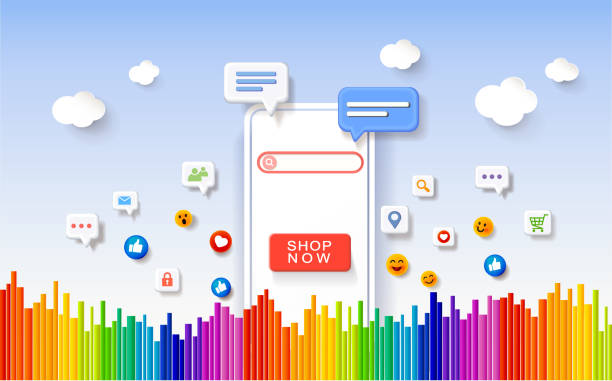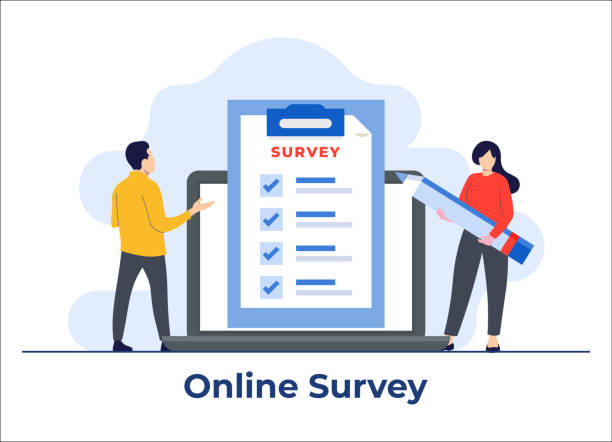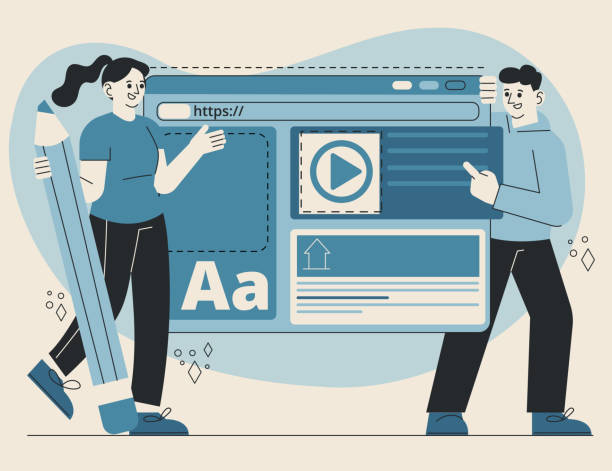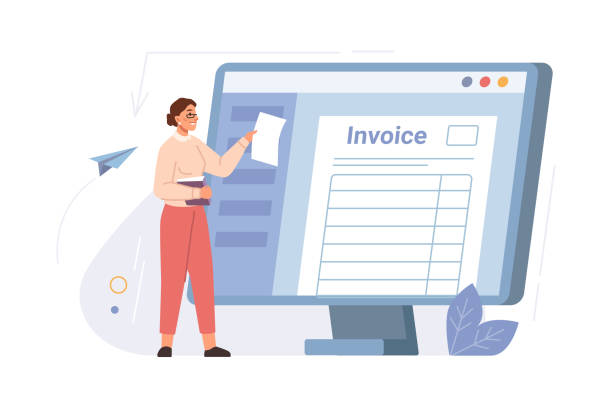The Importance of User-Friendly Website Design for Business Success

In today’s digital world, where competition is at its peak and users quickly move between different platforms, user-friendly website design is not just a competitive advantage, but a vital necessity for any business.
An efficient and #user-friendly #website is your main gateway to communicating with customers and target audiences, and it is the first point of contact for many users with your brand.
If visitors cannot easily navigate your site, find the information they need, or simply complete their desired process, such as making a purchase or signing up, they will undoubtedly leave your site within seconds and go to competitors.
This unpleasant scenario will lead to a significant increase in the Bounce Rate and a considerable decrease in the Conversion Rate.
A poor user experience can seriously damage your brand’s credibility, create a negative image, and consequently, result in the loss of countless opportunities for business growth and development.
For this reason, smart investment in designing a website that fully meets and even exceeds user needs and expectations is of high importance.
A website with user-friendly design can significantly increase engagement rates, keep visitors on different pages of the site for longer, and ultimately lead to increased sales, strengthened customer loyalty, and the creation of a stable user base.
A deep understanding of how users interact with your site, what obstacles they might encounter, and what factors influence their final decision, is the first and most fundamental step towards building a successful and sustainable digital experience.
A well-designed site not only satisfies the user but also acts as a powerful marketing tool and ultimately paves the way for your business growth and profitability.
Is your current corporate website not reflecting your brand’s credibility and power as it should? Rasaweb solves this challenge for you with professional corporate website design.
✅ Increased credibility and visitor trust
✅ Targeted attraction of more customers
⚡ Click for free consultation!
Basic Principles of User Experience (UX) Design for Websites

User Experience (#UX) design goes beyond the visual appearance of a website; this field addresses all aspects of user interaction with a product or service, aiming to create a positive and efficient experience.
To achieve a truly user-friendly website design, adhering to basic UX principles is essential, as they act as the backbone of every successful website.
The first and most important principle is Usability; meaning users should be able to perform their tasks easily, without confusion, and with minimal effort.
This includes simple and logical navigation, clear and understandable forms, and friendly and informative error messages.
The second principle is Accessibility, which ensures your website is usable for all individuals with different abilities, including those with visual, auditory, or motor impairments.
Using alternative text (alt text) for images, appropriate color contrast for better text readability, and full keyboard usability are examples of vital actions in this area.
The third principle is Value; your website should offer content or services that are truly valuable to the user and effectively meet their needs, not just irrelevant information.
Finally, Credibility by providing accurate and reliable information, and Desirability, which refers to the attractive appearance and good feeling of the website, also play important roles.
A good design should not only be functional and reliable but also evoke positive emotions in the user and encourage them to return and interact more.
These principles form the backbone of any successful design, and without them, even the most beautiful websites will be doomed to failure.
A deep understanding and correct implementation of these concepts help designers create products that are not only beautiful but also effectively serve users and achieve business goals.
User Interface (UI) and its Role in User-Friendly Website Design

While UX (User Experience) deals with the overall user interaction with the product and their feelings, #User Interface (UI) relates to the visual appearance and feel of the product; in other words, UI is what the user sees and directly interacts with.
UI includes all tangible or clickable visual elements that the user interacts with: buttons, icons, images, typography (font type and size), color palette, and the overall layout of pages.
A good UI improves the user experience and makes the website visually attractive, pleasing, and enjoyable to use.
Choosing an appropriate color palette that aligns with the brand, using legible fonts with clear visual hierarchy, and an organized layout that displays elements logically and predictably, all play a vital role in creating an effective user interface.
In user-friendly website design, UI must be visual and intuitive; meaning users without the need for training or a guide, should be able to understand the function of each element and predict what will happen after clicking or touching it.
For example, a button should look like a button and be clickable, or a link should be clearly distinguishable.
Harmony and synergy between UI and UX are crucial: a beautiful UI without functional UX is just a hollow appearance and won’t lead the user to their destination, and excellent UX without an attractive UI can seem boring and unengaging.
In fact, UI is a powerful tool that delivers UX to users.
Focusing on small details such as whitespace to reduce clutter, precise alignment of elements to create visual order, and clear visual feedback during user interaction (such as a button changing color when hovered over), can make a big difference in the final experience.
UI designers should always be aware of the latest design trends but at the same time, not neglect classic design principles to create an evergreen, effective, and appealing user interface that meets the present and future needs of users.
Comparing Features of Good and Bad User Interface (UI)
| Feature | Good UI (User-Friendly) | Bad UI (Unfriendly) |
|---|---|---|
| Navigation | Clear and organized menus, logical and predictable paths | Cluttered menus, hidden or illogical links, creating confusion |
| Design Consistency | Consistent use of colors, fonts, icons, and interactive patterns | Visual inconsistency, sudden style changes across different pages |
| Feedback | Clear messages for user actions (e.g., success, error, loading) | Lack of notification, vague and confusing messages, no status indication |
| Readability | Text with appropriate contrast and legible and sufficiently large fonts | Poor text and background contrast, illegible or very small fonts |
| Aesthetics | Pleasing, modern, and attractive visual appearance that gives the user a good feeling | Cluttered, outdated, unattractive design, or inappropriate color scheme |
Website Loading Speed and Performance Optimization

In the current era where #speed of life and access to information has become a principle, #website loading #speed is one of the most important factors in user experience and the online success of any business.
Numerous studies have shown that even a delay of a few hundred milliseconds in page loading can lead to a significant increase in the Bounce Rate and discourage the user from continuing activity on the site.
Users who encounter a slow and delayed website will undoubtedly leave it and go to faster competitors, as time is their most valuable asset.
This not only negatively impacts the user experience and damages brand credibility but also affects website SEO; search engines like Google prefer fast websites and display them higher in search results, as their goal is also to provide the best and fastest possible experience to their users.
To optimize loading speed and achieve a user-friendly website design, there are several technical solutions.
Reducing image size with proper compression and using next-generation image formats (such as WebP), compressing and minifying codes (CSS, JavaScript, HTML) to reduce file sizes, optimal use of browser caching to store static elements, and choosing appropriate and high-speed hosting are among these solutions.
Also, optimizing server-side codes, minimizing HTTP requests, and using Content Delivery Networks (CDNs) can significantly increase site speed.
The ultimate goal of all these measures is to provide a smooth, uninterrupted, and enjoyable user experience that allows users to quickly and easily access the information they need, and consequently, leads to increased satisfaction, loyalty, and engagement with the site.
In today’s competitive world, speed is no longer a luxury feature, but an indispensable and essential component of any successful and user-friendly website.
Are you frustrated with the low conversion rate of your e-commerce site? Rasaweb transforms your e-commerce site into a powerful tool for attracting and converting customers!
✅ Significant increase in visitor-to-buyer conversion rate
✅ Exceptional user experience for increased customer satisfaction and loyalty⚡ Get a free consultation from Rasaweb!
Responsive Design and Compatibility with Various Devices

Given the increasing diversity of devices used to access the internet, from smartphones and tablets to laptops, desktop computers, and even smartwatches, #Responsive Design has become a fundamental and indispensable principle in user-friendly website design.
Responsive design means designing a website whose #layout and #content automatically and intelligently adjust to the screen size and orientation of the user’s device, without the need to create separate or sub-versions for each device.
This approach ensures that users, regardless of the device they use, always have an optimal, comfortable, and seamless visual and functional experience.
Non-responsive or traditional websites may not display correctly on smaller devices; texts may be too small and unreadable, images cut off, and buttons and interactive elements unclickable or too small, which quickly leads to user frustration, increased bounce rate, and site abandonment.
In addition to significantly improving user experience and accessibility, responsive design is also highly important for SEO.
Google and other search engines prioritize responsive websites and favor them for ranking in mobile search results (Mobile-First Indexing).
Correct implementation of responsive design requires the use of fluid grids, flexible images, and media queries in CSS, which allows designers to apply different design rules for various screen dimensions.
This approach not only reduces the maintenance and update burden of the website but also helps businesses reach a wider audience, increase their conversion rates, and ultimately lead to sustainable growth and success in the online space.
In today’s world, where more than half of web traffic comes from mobile devices, a non-responsive site means ignoring a large portion of the audience.
Engaging Content and Its Role in User Retention
![]()
As much as the attractive appearance and flawless technical performance of a website are important, its #content also plays a vital and irreplaceable role in attracting, retaining, and converting users.
A user-friendly website design, without engaging, relevant, and valuable content, is like a beautiful, well-bound book whose inner pages lack any readable or meaningful material.
Content includes any information or media presented to the user: from written texts, images, and videos to infographics, audio files, and charts.
Quality content must first be #valuable, meaning it answers user questions, solves their problems, or teaches them new knowledge.
The second feature is its #relevance to the needs and interests of the target audience; content that is irrelevant to the user quickly tires and discourages them.
And third, its #readability and #understandability.
Using simple and understandable language, dividing text into short and smooth paragraphs, using subheadings (Headings), bulleted lists, and highlighting keywords, greatly increases content readability and allows users to easily find the information they need.
In addition to textual content, visual content such as high-quality and engaging images and videos can also significantly increase user interaction and convey your message more effectively and memorably.
#Entertaining and #interactive content, such as surveys, quizzes, small games, or interactive forms, can keep users on the site longer and make their experience more enjoyable.
Finally, regular and continuous content updates not only encourage users to return and show that your site is dynamic but also send a positive signal to search engines that your site is an active and reliable source.
A strong and targeted content strategy is an inseparable complement to a well-designed website and ensures that visitors not only enter your site but also stay there, trust it, and ultimately become loyal customers.
SEO and User-Friendly Website Design: An Inseparable Link

When it comes to SEO (Search Engine Optimization) and user-friendly website design, it must be said that these two concepts are inextricably linked and inseparable.
In fact, one cannot be fully achieved without considering the other.
A website with excellent visual design and flawless coding, but without optimization for search engines, is like a beautiful storefront on a quiet street: no one sees it or discovers it.
Similarly, a site that is only optimized for SEO and has tried to rank with various keywords but has a poor user experience (e.g., difficult navigation or slow speed), may attract visitors but cannot retain them and ultimately loses them.
Search engines like Google give increasing importance to #user experience (UX) factors in their ranking algorithms.
They have found that websites providing a better user experience are more valuable to users and therefore deserve higher rankings.
Page loading speed, responsiveness (mobile compatibility), easy and intuitive navigation, proper content structuring, content quality and depth, and user dwell time on the site, are all important factors that positively impact both SEO and user experience.
In fact, user-friendly website design directly helps improve SEO, as search engines aim to provide the best and most relevant experience possible to their users.
When a website is user-friendly, the bounce rate decreases, user dwell time on pages increases, and the click-through rate (CTR) from search results improves; all these send strong positive signals to search engines that your website is a valuable, reliable, and useful resource for users.
Therefore, any investment in improving user experience is simultaneously an investment in improving SEO and increasing the site’s visibility in search results, and these two should be considered complementary.
The Relationship Between SEO and Website User-Friendliness Factors
| User-Friendliness Factor (UX) | Direct and Indirect Impact on SEO | Explanation and Example |
|---|---|---|
| Page Loading Speed | Direct ranking factor, reduced bounce rate, improved Core Web Vitals | Faster sites appear higher in search results and provide a better user experience. |
| Responsive Design (Mobile-Friendliness) | Importance for Google’s Mobile-First Indexing, better ranking in mobile search | Google prioritizes mobile-friendly websites and ranks them better on mobile. |
| Easy and Intuitive Navigation | Reduced bounce rate, increased user dwell time, improved indexing by bots | Logical site structure helps users and search bots find content more easily. |
| Quality and Relevant Content | Increased engagement signals (e.g., time on page), attracting natural backlinks, increased organic traffic | Deep, informative, and useful content not only retains users but also boosts SEO ranking. |
| Website Security (HTTPS) | Direct Google ranking factor, building user trust | Google encourages sites with SSL certificates (HTTPS) and gives them better rankings. |
| Readability & Visual Design | Increased user dwell time, reduced bounce rate, increased click-through rate | Attractive and readable design makes users stay on the site longer and explore more. |
Continuous Testing and Improvement of User Experience

Building a website with #user-friendly website #design is not a static, one-time process, but requires #continuous #testing and improvement.
In the rapidly changing digital world, user expectations and behaviors are constantly evolving, and new technologies are rapidly emerging.
Therefore, to maintain the effectiveness of your website, you must continuously monitor and optimize its performance to always stay one step ahead of the competition.
Powerful analytical tools such as Google Analytics provide countless information about site traffic, acquisition channels, popular pages, and user paths.
Tools like Hotjar or Microsoft Clarity also allow you to observe user behavior with Heatmaps, Session Recordings, and surveys, gaining deep insights into how they interact with the site.
These tools help you identify and address user #pain points and common problems.
For example, if data shows that users are abandoning the site at a specific stage of the purchase process, you should review this stage and remove any potential obstacles.
Other methods such as A/B Testing to compare two different versions of a page or element, and Usability Tests with real users, are also effective ways to gather direct and reliable feedback from users.
This feedback helps you discover the strengths and weaknesses of your design and make data-driven decisions.
A dynamic website is one that is constantly evolving and adapting to the changing needs of users.
Small, continuous improvements based on user data and feedback can lead to significant results over time and ensure that your website always provides an optimal experience to users and outperforms competitors.
This analytical and iterative approach is key to longevity and success in the competitive web space.
How much does losing business leads due to an unprofessional site cost you? Solve this problem forever with professional corporate website design by Rasaweb!
✅ Increased credibility and trust of potential customers
✅ Easier attraction of new business leads⚡ Get a free consultation now!
New Challenges and Solutions in Modern Web Design

With the accelerating advancement of technology and rapid changes in user habits and expectations, #modern web #design faces new and complex challenges that must be addressed comprehensively and creatively to achieve a #user-friendly website design.
One of the biggest and most important challenges is the endless variety of devices and screen sizes; from small smartwatches to large smart TVs.
This diversity necessitates more advanced solutions such as Mobile-First design (designing for mobile first and then expanding to larger dimensions) and implementing flexible and scalable design systems.
Another challenge is maintaining #data privacy and #security in cyberspace, which has gained increasing importance with the rise of cyberattacks and users’ concerns about their personal information.
Websites must use strong security protocols (such as HTTPS), regularly perform security updates, and have complete transparency regarding how user data is collected, stored, and used to gain their trust.
Also, increasing user expectations for personalized and interactive experiences drives designers towards using Artificial Intelligence (AI) and Machine Learning (ML) to provide more relevant content, exclusive offers, and quicker responses to individual needs.
These challenges, at the same time, present unique opportunities for innovation and advancement in web design.
Using new and powerful frameworks (such as React, Vue, Angular), advanced design tools (such as Figma, Sketch), and Agile methodologies in web development, can assist designers in facing these challenges and make the design process more efficient.
A correct understanding of these challenges and finding creative and technological solutions for them not only helps improve the quality and efficiency of websites but also paves the way for creating next-generation digital experiences that are beautiful, functional, and secure.
The Future of Website Design and Artificial Intelligence

The future of #web #design, especially in the field of #user-friendly website #design, will be strongly influenced by significant and transformative advancements in #Artificial Intelligence (AI) and #Machine Learning (ML).
AI has the potential to revolutionize how websites are designed, developed, and optimized, elevating the user experience to unprecedented levels.
Imagine a website that automatically adjusts its layout, content, and even navigation path based on each user’s behaviors, preferences, and individual needs; this level of personalization and adaptability will uniquely improve the user experience.
AI-powered design tools can help designers better understand complex user behavioral patterns, generate design ideas with greater speed and accuracy, and even create optimized codes for user experience, significantly reducing design time.
AI-powered chatbots can improve 24/7 customer support and provide immediate, accurate, and personalized answers to their questions, which is a very important part of user-friendly website design and excellent service delivery.
Furthermore, AI can play an important role in optimizing loading speed by anticipating user needs, improving SEO by analyzing big data and identifying keyword opportunities, and even automatically identifying website security vulnerabilities.
However, it is important that alongside the use of these advanced technologies, the human element, creativity, and intuition of designers are not forgotten.
Artificial intelligence is a powerful tool that can help designers create better and more efficient websites, but it will never replace a deep understanding of user psychology, human needs, and the ability to create emotional connections with the audience.
An future where AI plays a prominent role in web design is an exciting future, full of new possibilities, and requires continuous readiness and innovation from designers and developers.
Frequently Asked Questions
And other services of Rasa Web Advertising Agency in the field of advertising
Smart Marketplace: A fast and efficient solution for digital branding with a focus on key page optimization.
Smart Custom Software: A combination of creativity and technology to increase click-through rates by using real data.
Smart UI/UX: An innovative service to increase click-through rates through key page optimization.
Smart Advertising Campaign: A creative platform to improve SEO ranking with precise audience targeting.
Smart Google Ads: An effective tool to increase website traffic with marketing automation.
And over hundreds of other services in the field of internet advertising, advertising consultation, and organizational solutions
Internet Advertising | Advertising Strategy | Advertorials
References
Comprehensive Guide to User Experience Design
Difference between UI and UX in Website Design
10 Key Tips for User-Friendly Website Design
How to Design a User-Friendly and Effective Website?
? Do you want to revolutionize your business in the digital world? Rasaweb Afarin Digital Marketing Agency, with its expertise in WordPress website design, SEO, and content marketing, is your comprehensive solution for online growth and prominence.
📍 Tehran, Mirdamad Street, next to Bank Markazi, Kazeroun Jonoubi Alley, Ramin Alley, P.O. Box 6
